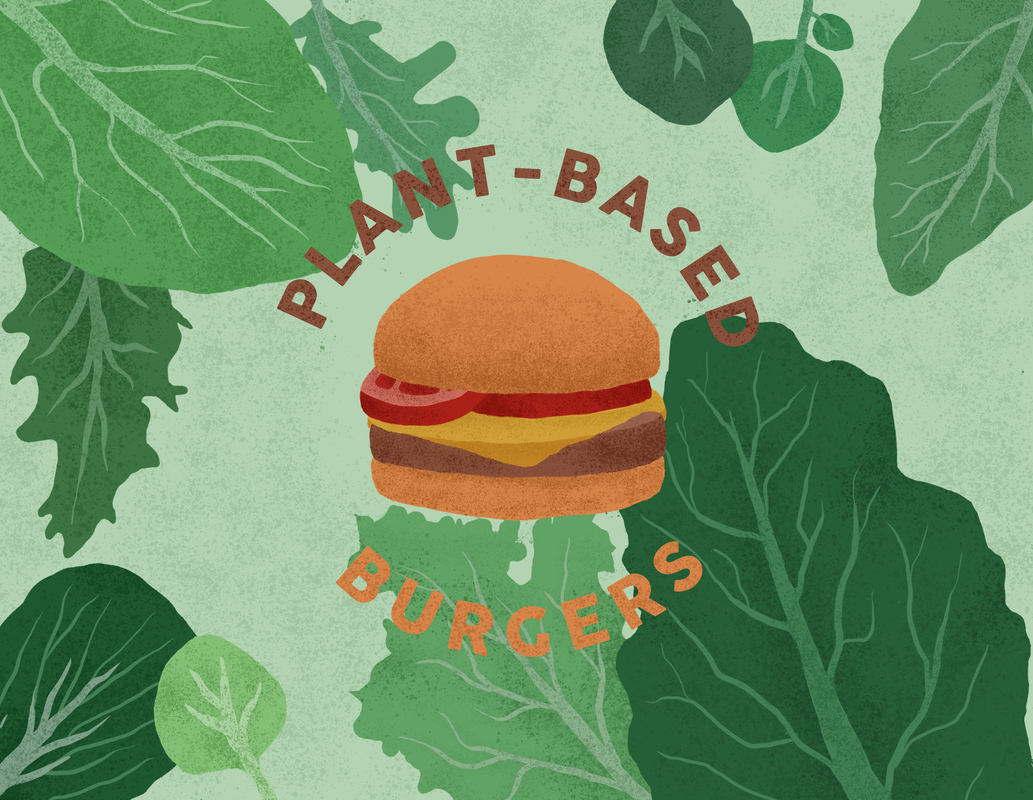|
By Michelle Lu Who doesn’t love burgers? The unique smell, taste, texture, and sizzle when flipping the beef patty on the grill all contribute to a perfect burger. Beyond their taste, however, beef burgers are far from perfect. While the health risks associated with high red meat consumption are widely known, many may not know that the amount of carbon dioxide that is given off from raising a pound of beef is, in fact, greater than that of burning a gallon of gasoline. Furthermore, cattle, pigs, and chickens are major incubators for dangerous viruses, and the clearing of forests to raise animals also drives habitat loss and the extinction of wild species. Food manufacturing companies have long been searching for plant-based meat alternatives, usually geared towards people with dietary restrictions, such as vegetarians. Among the most popular brands are Beyond Meat and Impossible Foods, which you may have seen in restaurants or even dining halls. In fact, with the recent trend of healthier lifestyles, nearly one in four Americans (23 percent) report eating less meat in the past year than they had previously. In addition, when the COVID-19 pandemic disrupted meatpacking facilities and caused panic about a potential meat shortage, many consumers turned to plant-based alternatives. Sales of plant-based meat substitutes jumped 35 percent from April 12 to May 9 this year. Impossible Foods reports that its grocery store footprint has increased eighteen-fold since March, and it expects to see a fifty-fold rise by the end of 2020. So what exactly are “fake” burgers? Do they really taste just like meat? Are they safe to consume long-term? Well, to be honest, most plant-based meat alternatives on the market today are still far away from tasting like real meat. However, Impossible Foods claims that, with its special added ingredient heme (in addition to wheat, corn, soy, coconut, and potatoes), its “Impossible Burger has all the satisfying flavor, nutrients, and sizzle you love, but it’s made from plants!” Heme is an essential iron source for humans, giving meat its bloody taste when raw and creating intense, meaty flavors and aromas when cooked. The major source of heme in meat is the protein myoglobin. More specifically, myoglobin is found in the red blood cells of muscle tissue in animals. It turns out that soybeans make a functionally identical protein known as leghemoglobin. Leghemoglobin is the byproduct of the symbiotic relationship between root nodules (found on the roots of plants that form a symbiosis with nitrogen-fixing bacteria) on legumes and nitrogen‐fixing bacteria that live on them. Unfortunately, it is made in the roots, which makes it difficult to collect. To solve this problem, technicians at Impossible Foods have extracted genes that code for the soy leghemoglobin protein and inserted them into a species of yeast called Pichia pastoris. They feed the modified yeast sugar and minerals, prompting it to grow and replicate. Thus, they have been able to manufacture heme with a fraction of the footprint of field-grown soy. With this process, Impossible Foods claims it can “generate 87 percent less greenhouse gases, require 95% less [land,] and use 75% less water to produce than burgers from cows.” In terms of energy consumption, a plant-based diet appears to be much more sustainable than the average American meat-based diet, but we should also look at any possible tradeoffs in health effects. Diets high in red meat are associated with many negative health consequences including obesity, type 2 diabetes, cardiovascular disease, and some cancers. Studies show that replacing red meats with plant-based protein sources reduces risks of these diseases, as well as LDL (which is considered the “bad” kind of cholesterol because it can deposit itself in artery walls) and total cholesterol. While much of the Impossible burger’s nutritional profile is the same or better than that of a beef burger, plant-based meats do have higher amounts of sodium. Furthermore, popular plant-based meat brands such as Impossible Foods and Beyond Meat do not use natural plant sources like legumes but rather highly processed purified plant protein, which leads to the loss of key nutrients. In addition, because processing creates highly palatable products, diets high in ultra-processed food like these burgers are susceptible to excess caloric intake and weight gain. Therefore, when considering reducing meat intake, perhaps consuming minimally processed plant foods that are high in protein (such as nuts and legumes) would be a better choice for nutritional and dietary considerations. As more and more Americans turn to plant-based meat alternatives, it will be worthwhile to conduct further research on the health effects of incorporating these novel plant-based meat products into our diet. With improvements in taste mimicry, plant-based meat can offer a viable option for individuals who want to reduce their meat consumption, and it certainly is more beneficial to the environment than beef burgers are. However, balancing these highly processed foods with other more nutritious natural foods will also be crucial. After all, a plant-based burger will never substitute for an actual serving of vegetables.
0 Comments
Leave a Reply. |
Categories
All
Archives
April 2024
|

